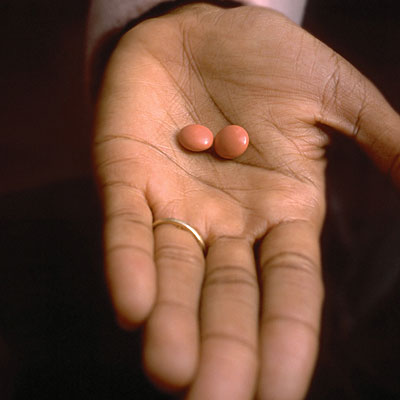Psoriatic arthritis treatment depends on the severity of symptoms, how they affect daily life, and whether there is joint damage or destruction, says Dan Fohrman, MD, a rheumatologist in private practice in Bend, Ore.
Some people need medication only when symptoms flare; others need strong medication to halt pain, swelling, and to slow or stop joint damage, Dr. Fohrman says.
"The effectiveness of these medications in some patients is nothing short of extraordinary," he says. Here are the treatment options.
Physical therapy
How it helps: Maintains range of motion, flexibility, and function in joints affected by psoriatic arthritis. A physical therapist tailors exercises that patients perform on a regular basis. Occupational therapists may also help people with pain in the hands and arms learn to perform daily activities at work and home more safely.
Need to know: Stephen Paget, MD, rheumatologist and physician-in-chief emeritus at the Hospital for Special Surgery, in New York City, recommends that all patients see a physical therapist and an occupational therapist to learn exercises and how to avoid overusing their joints. "It is a routine, important part of the care," he says.
Nonsteroidal anti-inflammatories (NSAIDs)
Names: Advil, Motrin, and Aleve, among others
How it helps: These reduce pain and inflammation. They are often the first drugs that patients take, and may be used alone (if symptoms are relatively mild) or in combination with other drugs.
Need to know: Side effects can include a risk of stomach pain, constipation, and diarrhea. Gastrointestinal bleeding, kidney damage, and high blood pressure are also possible side effects when used over time. They may also worsen psoriasis.
Disease-modifying antirheumatic drugs (DMARDs)
How they help: Many drugs that treat psoriatic arthritis are DMARDs, but methotrexate (Trexall) is the most common. Another is sulfasalazine (Azulfidine). They come in tablets and may take weeks or months to work. This drug class can slow or stop joint damage (unlike drugs that treat symptoms).
Need to know: They are often the first treatment, especially if NSAIDs aren't helping or arthritis is worsening. Side effects can include nausea, stomach pain, and light sensitivity. Methotrexate users are often monitored every one to three months for liver or blood cell problems.
Humira (adalimumab)
How it helps: Reduces joint damage and symptoms of arthritis. Humira and several other psoriatic arthritis drugs belong to a subclass of DMARDs that act by inhibiting TNF (tumor necrosis factor). TNF is a protein that is elevated in psoriatic arthritis patients and directly causes joint damage.
Need to know: TNF inhibitors, known as biologics, roughly double the risk of serious infections, says Dr. Paget. However, the risk of infection is still very low, Dr. Fohrman notes. Humira is given by injection every two weeks. Soreness at the site of injection and headache are also possible side effects.
Enbrel (etanercept)
How it helps: Reduces joint damage and symptoms of arthritis. Like Humira, Enbrel is a DMARD that targets TNF, helping to reduce inflammation and halt joint damage.
What you should know: Because Enbrel is a TNF inhibitor and suppresses the immune system, it carries a risk of infections, though studies suggest the infections are not usually serious. Dr. Paget says all TNF inhibitors share similar side effects and are equally effective at preventing joint damage and symptom reduction. However, Enbrel has a slightly different chemical structure than Humira and is injected once or twice a week.
Remicade (infliximab)
How it helps: Reduces joint damage and symptoms of arthritis. It belongs to the TNF-inhibiting group of DMARDs.
What you should know: Remicade has to be administered in a hospital or clinic every two to eight weeks because it is an intravenous infusion that takes about two hours. One quarter of the drug is a protein derived from mice, so there is a potential for an allergic reaction, Dr. Paget says. TNF inhibitors can cost from $15,000 to $25,000 annually. Insurance typically covers much of the cost, but Remicade is the most likely to be covered by Medicare because it is given in a clinical setting.
Simponi (golimumab)
How it helps: Another TNF inhibitor that reduces joint damage and symptoms of arthritis. Patients’ responses to TNF inhibitors vary greatly so numerous options need to be available, Dr. Fohrman says.
What you should know: Simponi, approved by the FDA in 2009, is one of the newer TNF inhibitors and doesn’t have the track record the others do. But the self-injectable medication is similar to the others, except it only has to be given once a month. It also increases the risk of infections, and upper respiratory infections are most common. Like the other TNF inhibitors, the drug comes with a warning about tuberculosis and invasive fungal infections.
Immunosuppressants
Names: Azathioprine (Imuran, Azasan), cyclosporine (Sandimmune, Neoral), leflunomide (Arava)
How it helps: Similar to methotrexate, these drugs suppress the immune system. They are also DMARDs, as they slow joint destruction.
What you should know: These are typically used only in very severe cases. Side effects include a risk of infection, anemia, and liver problems. Azathioprine and cyclosporine require monitoring every one to three months to check the liver and blood counts. Dr. Fohrman says he does not often prescribe cyclosporine because it also requires regular blood pressure and kidney tests.
Corticosteroids
Names: Prednisone (Prednisone Intensol, Sterapred); cortisone (injections)
How it helps: Corticosteroids, or steroids (although they aren't the same as anabolic steroids abused by some athletes), are powerful, immune-suppressing drugs. Prednisone is taken orally for short periods of time to cut pain and swelling. Cortisone injections into a joint can also temporarily ease pain and inflammation.
What you should know: Repeated injections can weaken tissue, damage nerves, and trigger flares of pain. Over time, steroids can cause bone thinning, weight gain, and facial swelling.
Surgery
Names: Joint replacement surgery; arthroplasty
How it helps: The surgery replaces the damaged joint with a prosthesis and can bring relief to painful joints. Replacement joints for the hands, which are often affected by psoriatic arthritis, are usually made out of silicone rubber.
What you should know: Surgery is reserved for people with joint destruction or pain that is not helped by medication and interferes with daily life. As with any surgery, it carries a small risk of complication, such as infection. Recovery usually involves physical therapy.
Source: health.com







